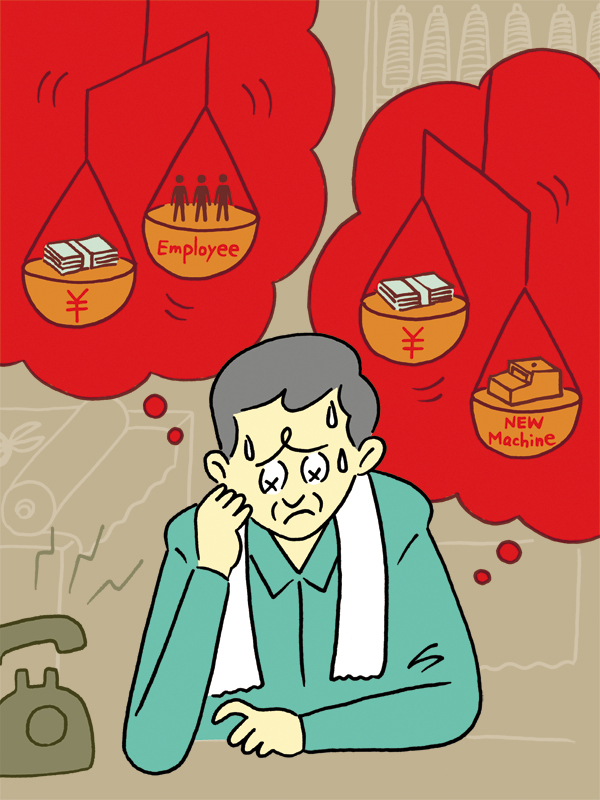“Made in Japan”—these words have begun popping up in the windows of Japanese stores, which previously were completely devoted to made-in-China products. This is because the spotlight has once again turned to how products made in Japan are synonymous with safety and security. However, made-in-Japan products comprise make up less than a mere 3% of apparel supplied to the market.
The volume of apparel produced domestically in 2014 was 121,670,000 items. Regardless of the growing interest in products manufactured in Japan, this volume declined by 10.3% year-on-year. Although made-in-Japan products are also highly popular among foreign visitors to Japan, the rate of decline in production volumes has not slowed down. If this trend continues, the day may come when it becomes impossible for us to obtain made-in-Japan apparel as and when we please.
Lower wages than convenience store employees
“The hourly wage at sewing factories is even lower than at convenience stores. It’s extremely difficult to attract young workers that way.” Such complaints are frequently heard in the manufacturing regions. The fact is that companies have resumed domestic production due to the depreciation of the yen and rising costs in China and Southeast Asia with no significant improvements to the wages paid to workers.
Tokyo Clothing, a leading sewing company and subsidiary of STYLEM Co., LTD., which specialises in the fibre trade, concluded operations on 24 July and commenced liquidation proceedings. According to the company, “We assessed that sustaining future business would be difficult, owing to rising personnel costs and an ageing population, as well as rising raw material and material costs.”
As a result of the slump in consumption, purchasing parties have also become hyper-vigilant in keeping costs as low as possible, even when it comes to products that are made in Japan. Hence, the difficulty in passing on costs onto the retail price is also an issue all manufacturing companies are faced with, regardless of the scale of the company.
Even in the Japanese textile industry, highly appraised by European brands, many companies engaged in the key processes of dyeing, processing, and fabric weaving have collapsed, resulting in manufacturing regions facing increasing difficulties in sustaining their production chain.
The premise of full capacity utilisation
A wide gap divides the manufacturing industry and the distribution industry.
As the term implies, the manufacturing industry possesses countless production facilities, encompassing specialised machinery for the respective products and processes, such as spinning machines for yarn; looms for textiles; and dyeing machines for the dyeing process.
Most of the equipment is enormous, but helps minimise costs by producing large quantities in one shot. Regardless of whether the material produced is yarn or textile, this production structure has remained the same for over a century.
Advancements in equipment have enabled the stable production of high-quality products. However, at the same time, this calls for significant investments in equipment, as well as operating costs. For this reason, the manufacturing industry has always adopted a profit structure that strikes a balance with the mass-production of high-quality products. Production has typically been based on full utilisation of capacity.
Looking at the example of weaving companies in Bishu that produce material for womenswear, we see that the model around 1989 generated on average gross profit of more than 15%, expenditures of 11%, bank interest of 2.7% (related to the purchase of yarn, etc.), and operating and ordinary income of 2.8%. In 1994, gross profit was 16%, but expenditures had increased to 14.5% while operating and ordinary income had declined to 1.6%.
The decline continued thereafter, and after the world financial crisis in 2008, expenditure exceeded gross profit, while operating loss reached a level of about 2%. One after another, companies went bankrupt or out of business. This situation is thought to be common across all companies in the manufacturing region.
Such changes in business performance are consistent with the pace of overseas relocation among companies in the manufacturing industry. Discussions have taken place concerning the diversification of consumption in Japan, and widespread moves to produce staple products overseas and differentiated products in Japan.
Furthermore, the public and private sectors alike have extolled the switch in mindset from product-oriented to market-oriented manufacturing, bringing about changes to the overall industrial structure of the fashion business.
In terms of the companies placing orders, there has been a growing trend toward multi-product small-lot production. However, with greater penetration of the market-oriented mindset, profitability for apparel has declined in tandem with intensifying price competition as a result of product homogenisation.
If mass-production facilities follow multi-product small-lot production, profitability among the manufacturing industry will naturally decline. However, due to poorer profit margins, the retail side has also failed to meet rising costs in the manufacturing industry, creating a vicious cycle.
As Bishu’s example, described earlier, shows, even though gross profit has remained stable, decline in production efficiency has also contributed to the continued rise in expenditure. Another important factor lies in the fact that the prices for domestically-produced textiles do not rebound after being dragged downward by the prices of cheap textiles produced overseas.
Many manufacturers have disappeared from the scene after experiencing declines in revenue, amidst their failure to introduce equipment and facilities capable of meeting the needs of the new business model.
Companies have emerged which insist that if the concept of market-orientation is pursued further, ultimately everything comes down to responding to the needs of individual customers. Production sites are also speaking out against today’s extreme market-orientation. How will they overcome the “differences in basic unit of output” between producers and retailers? The industry needs wisdom more than ever today.
Illustration : shozo toriizuka(ofutari)

